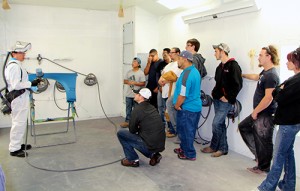Dunwoody’s Automotive Collision Repair & Refinishing Department recently held a free, six-hour training session on aqueous paint systems for collision repair. The training was followed by an in-booth waterborne base coat and clear coat spot repair demonstration.

The purpose of the training was to inform the public—especially those in the automotive industry—the benefits of using, and properly applying, waterborne paint, instead of traditional solvent-based paint, on a newly repaired vehicle.
Nearly 30 individuals participated in the demo, including representatives from Heppner’s Auto Body & Collision Repair; Keystone Refinish (LKQ Corp); Minnesota Technical Assistance Program (MNTAP); University of Northern Iowa Waste Reduction Center; Environmental Initiative Group; Kansas State University; PPG Automotive Refinish; and the City of Minneapolis were in attendance.
The training comes at a time when many auto repair shops are adopting the more environmentally friendly paint system technologies.
The Benefits of Using Waterborne Based Paint
Over the last few years, water-borne based paints have gained  traction around the U.S. and internationally. They have been proven to:
traction around the U.S. and internationally. They have been proven to:
- Produce better color matches;
- Improve spot repairs;
- Reduce solvent exposure;
- Emit fewer air pollutants; and
- Produce less hazardous waste–making them a popular choice in many auto repair shops.
Due to this shift in technology, Dunwoody installed a waterborne spray paint booth in its Collision Repair Shop earlier this year. The booth was made possible through several donations and a grant from the City of Minneapolis. Since then, the Automotive Collision & Repair program’s curriculum has drastically changed, focusing heavily on waterborne-paint application.
Event Attendees Learn Best Practices from Local Professionals
Dunwoody’s curriculum, additional grant opportunities from the City of Minneapolis, and waterborne paint application tips and techniques, were discussed at the event. Attendees were also able to participate in a virtual paint demonstration, which analyzes a person’s spray technique, rates their overall performance, and provides helpful feedback on how the painter can improve.
The program concluded with an actual waterborne spray paint demonstration inside Dunwoody’s paint booth.
Make the Switch to Waterborne: Learn More
Dunwoody’s seminar was held in conjunction with the Minnesota Technical Assistance Program (MnTAP) at the University of Minnesota; Environment
al Initiative; the City of Minneapolis; and MPCA’s Small Business Environmental Assistance Program (SBEAP). All organizations aim to improve air quality, eliminate waste, and better train local painters.
For more information on waterborne paint, contact Bruce Graffunder. For financial assistance opportunities to fund your shift to waterborne paint, contact the City of Minneapolis, MN Tap, or the Environmental Initiative Group.